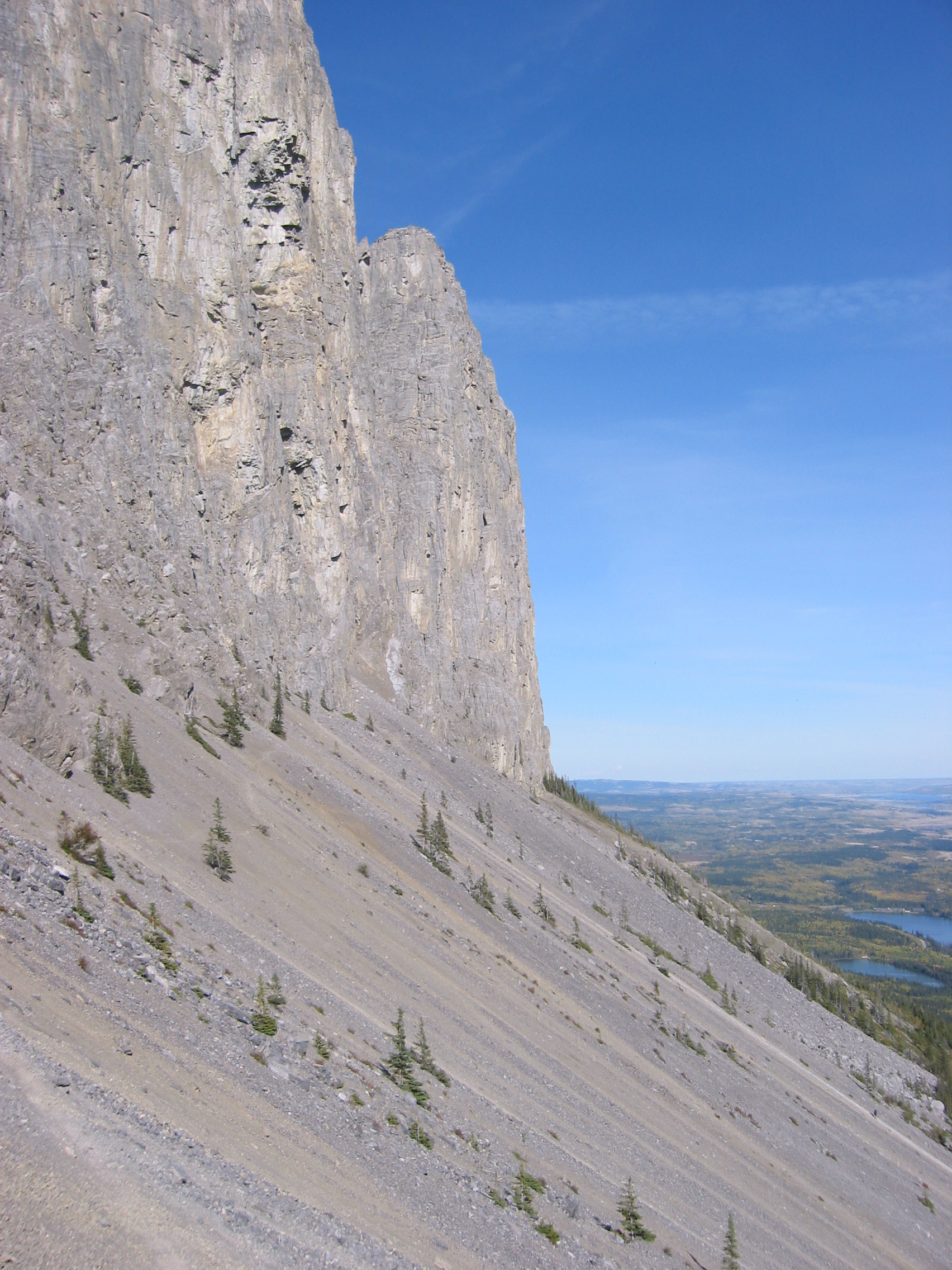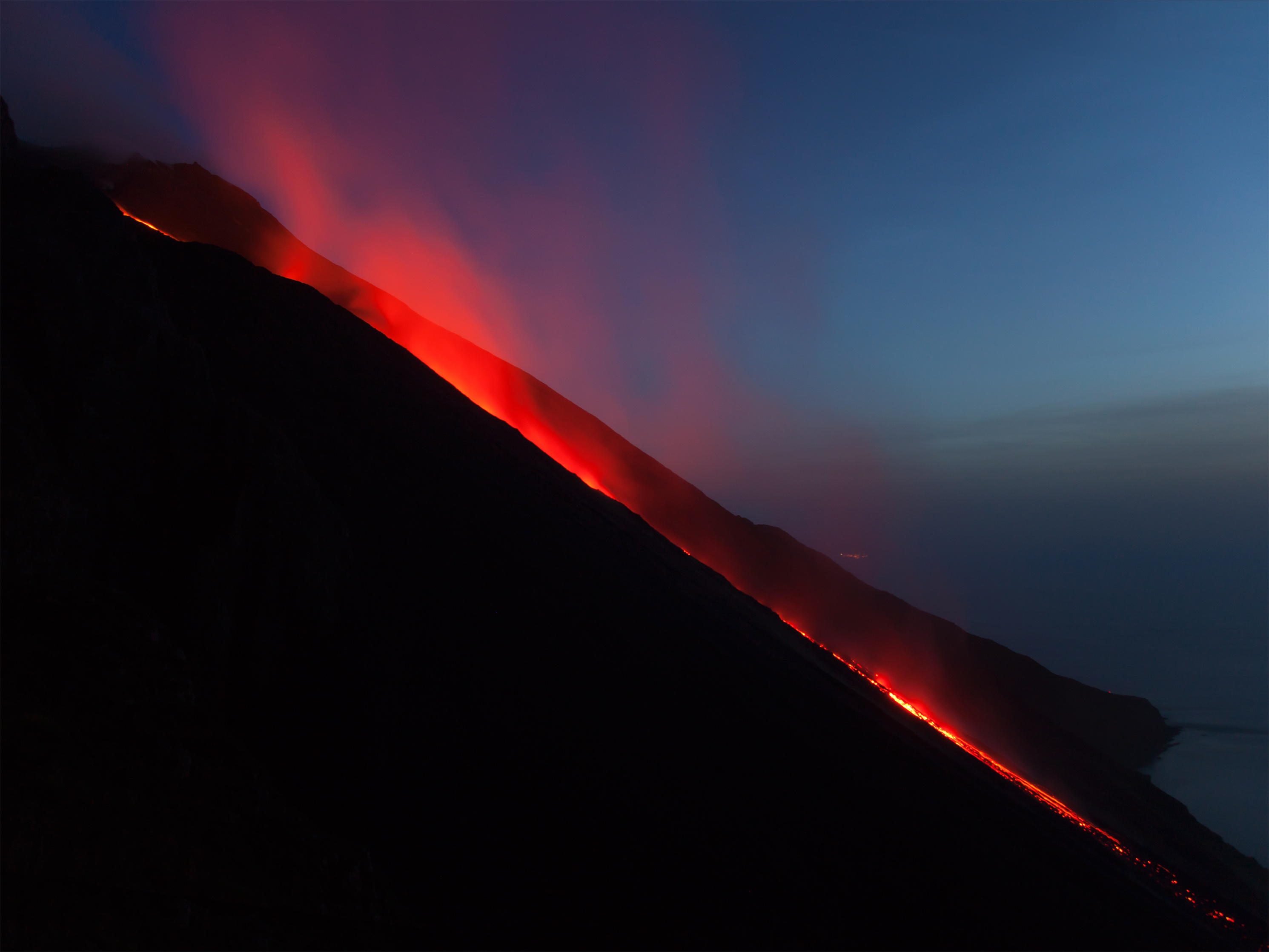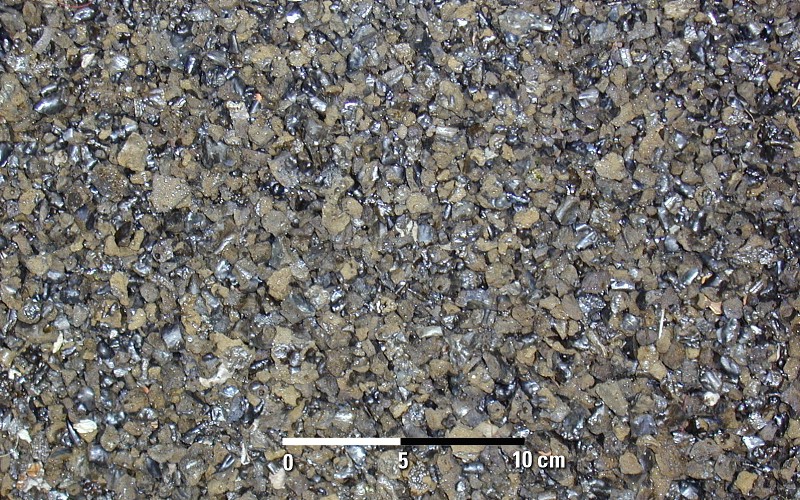|
Sciara Del Fuoco
Sciara del Fuoco is a Scree, talus scree or depression located on Stromboli, Stromboli Island in Italy. It runs along the island's northern flank and is bounded by two ridges. It now serves as a major tourist attraction on the island. Formation Sciara del Fuoco was formed as a result of a sector collapse around 5,000 years ago. Due to this, it is sometimes referred to as a scar. It was formed by lava, lapilli, and Incandescence, incandescent waste. References Volcanoes of Italy Stromboli Sector collapses {{Europe-geologic-formation-stub ... [...More Info...] [...Related Items...] OR: [Wikipedia] [Google] [Baidu] |
Scree
Scree is a collection of broken rock fragments at the base of a cliff or other steep rocky mass that has accumulated through periodic rockfall. Landforms associated with these materials are often called talus deposits. The term ''scree'' is applied both to an unstable steep mountain slope composed of rock fragments and other debris, and to the mixture of rock fragments and debris itself. It is loosely synonymous with talus, material that accumulates at the base of a projecting mass of rock, or talus slope, a landform composed of talus. The term ''scree'' is sometimes used more broadly for any sheet of loose rock fragments mantling a slope, while ''talus'' is used more narrowly for material that accumulates at the base of a cliff or other rocky slope from which it has obviously eroded. Scree is formed by rockfall, which distinguishes it from colluvium. Colluvium is rock fragments or soil deposited by rainwash, sheetwash, or slow downhill creep, usually at the base of gentle ... [...More Info...] [...Related Items...] OR: [Wikipedia] [Google] [Baidu] |
Stromboli
Stromboli ( , ; ) is an island in the Tyrrhenian Sea, off the north coast of Sicily, containing Mount Stromboli, one of the four active volcanoes in Italy. It is one of the seven Aeolian Islands, a volcanic arc north of Sicily, and the mythological home of Aeolus. The island, with an area of , represents the upper third of the volcano. Its population was about 500 . The volcano has erupted many times and is constantly active with minor eruptions, often visible from many points on the island and from the surrounding sea, giving rise to the island's nickname "Lighthouse of the Mediterranean". Etymology The name Stromboli is derived from the Ancient Greek name , () which was derived from (, 'round'), after the volcano's round, conical appearance when seen from a distance. Height and shape Stromboli stands above sea level, and over above the sea floor. The area of Stromboli island is . As of June 2024, there are two active craters at the peak, each with multiple vents show ... [...More Info...] [...Related Items...] OR: [Wikipedia] [Google] [Baidu] |
Italy
Italy, officially the Italian Republic, is a country in Southern Europe, Southern and Western Europe, Western Europe. It consists of Italian Peninsula, a peninsula that extends into the Mediterranean Sea, with the Alps on its northern land border, as well as List of islands of Italy, nearly 800 islands, notably Sicily and Sardinia. Italy shares land borders with France to the west; Switzerland and Austria to the north; Slovenia to the east; and the two enclaves of Vatican City and San Marino. It is the List of European countries by area, tenth-largest country in Europe by area, covering , and the third-most populous member state of the European Union, with nearly 59 million inhabitants. Italy's capital and List of cities in Italy, largest city is Rome; other major cities include Milan, Naples, Turin, Palermo, Bologna, Florence, Genoa, and Venice. The history of Italy goes back to numerous List of ancient peoples of Italy, Italic peoples—notably including the ancient Romans, ... [...More Info...] [...Related Items...] OR: [Wikipedia] [Google] [Baidu] |
Ridge
A ridge is a long, narrow, elevated geomorphologic landform, structural feature, or a combination of both separated from the surrounding terrain by steep sides. The sides of a ridge slope away from a narrow top, the crest or ridgecrest, with the terrain dropping down on either side. The crest, if narrow, is also called a ridgeline. Limitations on the dimensions of a ridge are lacking. Its height above the surrounding terrain can vary from less than a meter to hundreds of meters. A ridge can be either depositional, erosional, tectonic, or a combination of these in origin and can consist of either bedrock, loose sediment, lava, or ice depending on its origin. A ridge can occur as either an isolated, independent feature or part of a larger geomorphological and/or structural feature. Frequently, a ridge can be further subdivided into smaller geomorphic or structural elements. Classification As in the case of landforms in general, there is a lack of any commonly agreed clas ... [...More Info...] [...Related Items...] OR: [Wikipedia] [Google] [Baidu] |
Tourist Attraction
A tourist attraction is a place of interest that tourists visit, typically for its inherent or exhibited natural or cultural value, historical significance, natural or built beauty, offering leisure and amusement. Types Places of natural beauty such as beaches, tropical island resorts, national parks, mountains, deserts and forests, are examples of traditional tourist attractions which people may visit. Cultural tourist attractions can include historical places, sites of significant historic wikt:event, event, monuments, ancient temples, zoos, public aquarium, aquaria, museums and art galleries, botanical gardens, buildings and structures (such as List of forts, forts, castles, library, libraries, former prisons, skyscrapers, bridges), theme parks and carnivals, living history museums, public art (sculptures, statues, murals), ethnic enclave communities, heritage railway, historic trains and cultural events. Factory tours, industrial heritage, creative art and crafts workshops a ... [...More Info...] [...Related Items...] OR: [Wikipedia] [Google] [Baidu] |
Sciara Del Fuoco
Sciara del Fuoco is a Scree, talus scree or depression located on Stromboli, Stromboli Island in Italy. It runs along the island's northern flank and is bounded by two ridges. It now serves as a major tourist attraction on the island. Formation Sciara del Fuoco was formed as a result of a sector collapse around 5,000 years ago. Due to this, it is sometimes referred to as a scar. It was formed by lava, lapilli, and Incandescence, incandescent waste. References Volcanoes of Italy Stromboli Sector collapses {{Europe-geologic-formation-stub ... [...More Info...] [...Related Items...] OR: [Wikipedia] [Google] [Baidu] |
Stromboli Sciara Del Fuoco In September 2014
Stromboli ( , ; ) is an island in the Tyrrhenian Sea, off the north coast of Sicily, containing Mount Stromboli, one of the four active volcanoes in Italy. It is one of the seven Aeolian Islands, a volcanic arc north of Sicily, and the mythological home of Aeolus. The island, with an area of , represents the upper third of the volcano. Its population was about 500 . The volcano has erupted many times and is constantly active with minor eruptions, often visible from many points on the island and from the surrounding sea, giving rise to the island's nickname "Lighthouse of the Mediterranean". Etymology The name Stromboli is derived from the Ancient Greek name , () which was derived from (, 'round'), after the volcano's round, conical appearance when seen from a distance. Height and shape Stromboli stands above sea level, and over above the sea floor. The area of Stromboli island is . As of June 2024, there are two active craters at the peak, each with multiple vents show ... [...More Info...] [...Related Items...] OR: [Wikipedia] [Google] [Baidu] |
Sector Collapse
A sector collapse or lateral collapse is the structural failure and subsequent collapse of a minimum volume of of a volcano. Unlike smaller flank collapses, a sector collapse can involve the central volcanic pipe and historically this term had been restricted by some writers to such events in arc stratovolcanoes, but is now used for large events in any volcano. Sector collapses are one of the most hazardous volcanic events, often resulting in lateral blasts, landslides, and changes in volcanic eruptive behavior. Sector collapse can be caused by earthquakes, volcanic eruptions, gradual volcanic deformation, and other processes. Sector collapse events can occur on volcanoes at convergent and divergent plate boundaries. Sector collapses are generally very sudden; however, some attempts have been made to predict collapse events. Causes Internal Sector collapse can result from internal volcanic processes. Volcanic eruption can damage originally stable magma chambers, caus ... [...More Info...] [...Related Items...] OR: [Wikipedia] [Google] [Baidu] |
Lava
Lava is molten or partially molten rock (magma) that has been expelled from the interior of a terrestrial planet (such as Earth) or a Natural satellite, moon onto its surface. Lava may be erupted at a volcano or through a Fissure vent, fracture in the Crust (geology), crust, on land or underwater, usually at temperatures from . The volcanic rock resulting from subsequent cooling is often also called ''lava''. A lava flow is an outpouring of lava during an effusive eruption. (An explosive eruption, by contrast, produces a mixture of volcanic ash and other fragments called tephra, not lava flows.) The viscosity of most lava is about that of ketchup, roughly 10,000 to 100,000 times that of water. Even so, lava can flow great distances before cooling causes it to solidify, because lava exposed to air quickly develops a solid crust that insulates the remaining liquid lava, helping to keep it hot and inviscid enough to continue flowing. Etymology The word ''lava'' comes from Ital ... [...More Info...] [...Related Items...] OR: [Wikipedia] [Google] [Baidu] |
Lapilli
Lapilli (: lapillus) is a size classification of tephra, which is material that falls out of the air during a volcanic eruption or during some meteorite impacts. ''Lapilli'' is Latin for "little stones". By definition lapilli range from in diameter. A pyroclastic particle greater than 64 mm in diameter is known as a volcanic bomb when molten, or a volcanic block when solid. Pyroclastic material with particles less than 2 mm in diameter is referred to as volcanic ash. Formation Lapilli are spheroid-, teardrop-, dumbbell- or button-shaped droplets of molten or semi-molten lava ejected from a volcanic eruption that fall to earth while still at least partially molten. These granules are the direct result of liquid rock cooling as it travels through the air. Lapilli tuffs are a very common form of volcanic rock typical of rhyolite, andesite and dacite pyroclastic eruptions, where thick layers of lapilli can be deposited during a basal surge eruption. Most lapilli tuf ... [...More Info...] [...Related Items...] OR: [Wikipedia] [Google] [Baidu] |
Incandescence
Thermal radiation is electromagnetic radiation emitted by the thermal motion of particles in matter. All matter with a temperature greater than absolute zero emits thermal radiation. The emission of energy arises from a combination of electronic, molecular, and lattice oscillations in a material. Kinetic energy is converted to electromagnetism due to Larmor formula, charge-acceleration or dipole oscillation. At room temperature, most of the emission is in the infrared (IR) spectrum, though above around 525 °C (977 °F) enough of it becomes Visible spectrum, visible for the matter to visibly glow. This visible glow is called incandescence. Thermal radiation is one of the fundamental mechanisms of heat transfer, along with Thermal conduction, conduction and Convection (heat transfer), convection. The primary method by which the Sun transfers heat to the Earth is thermal radiation. This energy is partially absorbed and scattered in the atmosphere, the latter process bei ... [...More Info...] [...Related Items...] OR: [Wikipedia] [Google] [Baidu] |
Volcanoes Of Italy
The volcanism of Italy is due chiefly to the presence, a short distance to the south, of the boundary between the Eurasian Plate and the African Plate. Italy is a volcanically active country, containing the only active volcanoes in mainland Europe (while volcanic islands are also present in Greece, in the volcanic arc of the southern Aegean). The lava erupted by Italy's volcanoes is thought to result from the subduction and melting of one plate below another. Three main clusters of volcanism exist: a line of volcanic centres running northwest along the central part of the Italian mainland (see: Campanian volcanic arc); a cluster northeast of Sicily in the Aeolian Islands; and a cluster southwest of Sicily around the island of Pantelleria, in the Mediterranean's Strait of Sicily. Sardinia has had a totally separate geological history from that of the rest of Italy, where several cycles of volcanic activity occurred, the last of which ended at the beginning of the Pleistoce ... [...More Info...] [...Related Items...] OR: [Wikipedia] [Google] [Baidu] |











